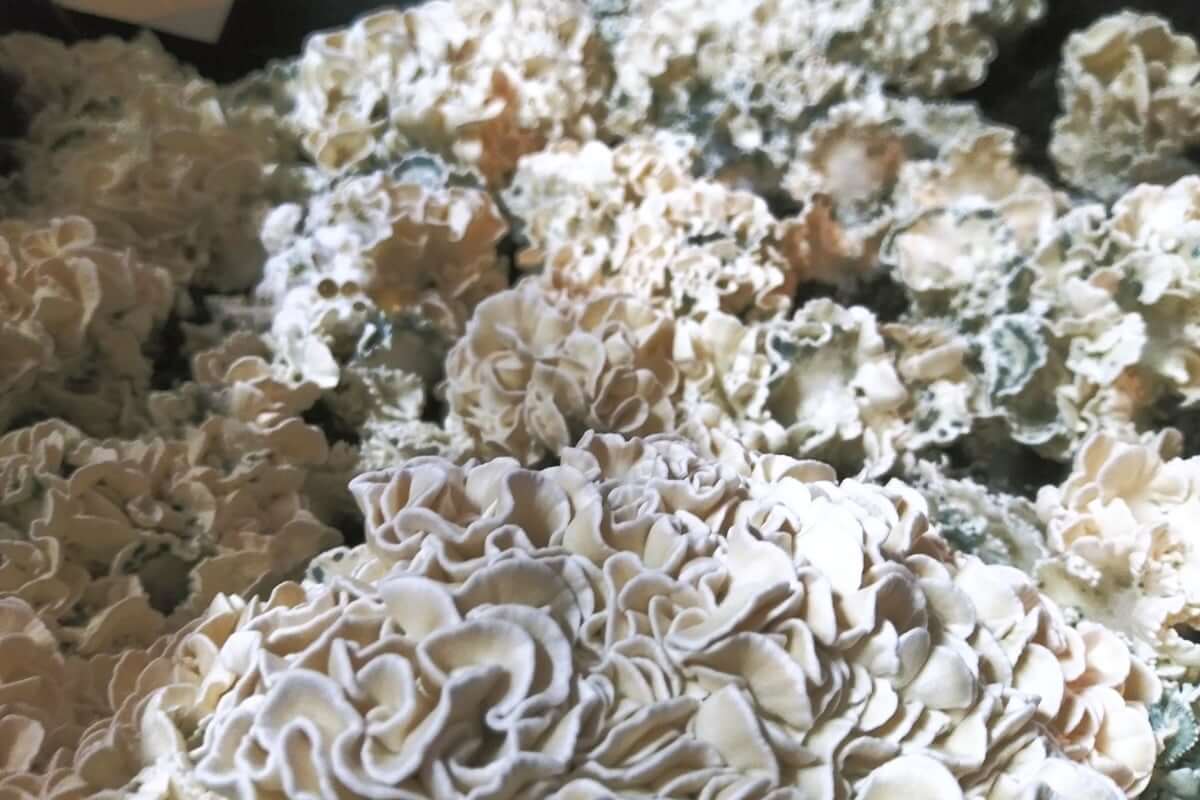If you’ve ever felt overwhelmed by the sheer number of Psilocybe cubensis strains available for microscopy research, you’re not alone. With tons of varieties from the classic Golden Teacher to the enigmatic Enigma mutation, choosing the right strain for your collection can feel like navigating a labyrinth. But here’s the thing: understanding the differences between cubensis strains isn’t just about variety for variety’s sake. Each strain brings unique characteristics to your research, whether that’s distinctive spore morphology, fascinating growth patterns, or simply the satisfaction of working with genetics that match your experience level. I’ve spent years working with these remarkable organisms, and I’m here to break down everything you need to know about the complete world of P. cubensis strains. No mycology PhD required!
Ready to Start Your Cubensis Research Journey?
Our Spore Bundle featuring Enigma, APE, and Golden Teacher gives you the perfect trifecta: a beginner-friendly classic, an intermediate albino variety, and an advanced mutation that’ll challenge and excite you. This collection represents the full spectrum of cubensis diversity, offering unparalleled value for microscopy enthusiasts who want to experience the remarkable range of genetics available in one convenient package.
Get the Complete Starter Bundle NowWhat We’ll Cover
- What is Psilocybe cubensis?
- Why Do Strains Differ?
- Complete Strain Comparison Table
- How to Choose Your Strain
- Growing Fundamentals
- Legal Considerations
- Frequently Asked Questions
What is Psilocybe cubensis?
Psilocybe cubensis stands as one of the most widely studied and cultivated species in amateur mycology. Originally described in 1906 by American mycologist Franklin Sumner Earle in Cuba (hence “cubensis”), this species has become the foundation of modern mushroom cultivation research due to its remarkable adaptability and relatively straightforward life cycle.
What makes P. cubensis so special? For starters, it’s incredibly cosmopolitan—naturally occurring in tropical and subtropical regions across the globe, from the Gulf Coast of the United States to Southeast Asia, Australia, and Central America. This wide distribution means the species has developed numerous regional variants, each adapted to slightly different environmental conditions. These natural variations form the genetic foundation for many of the strains we work with today.
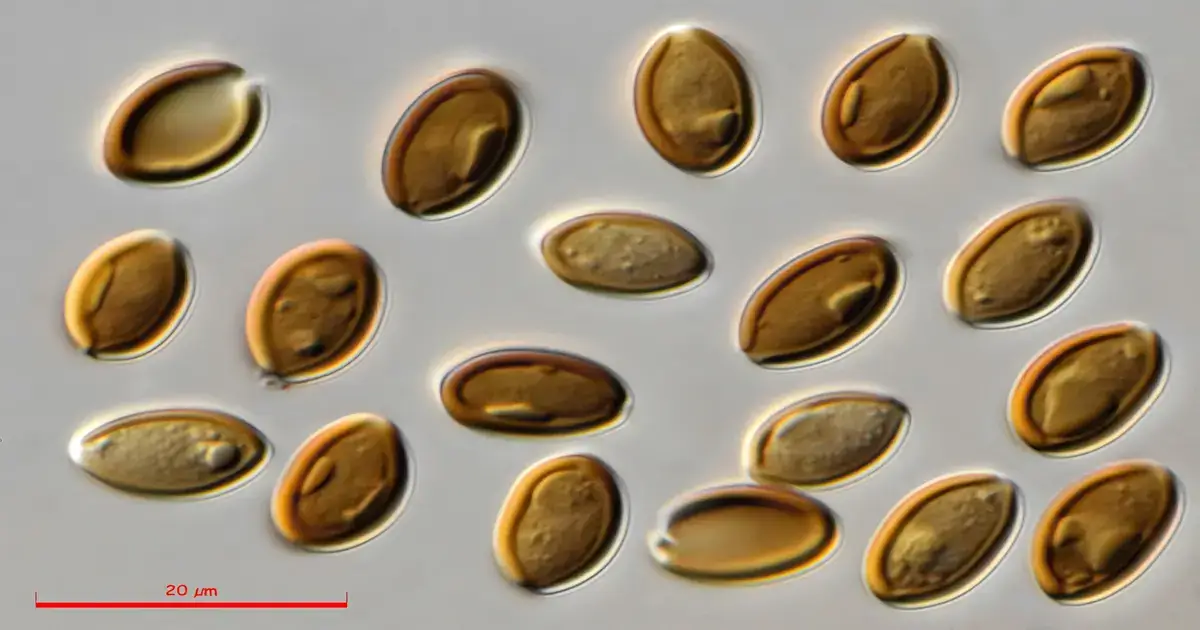
Under the microscope, P. cubensis spores are immediately recognizable. They’re sub-ellipsoid in shape, measuring approximately 11-17 x 7-12 microns, with a distinctive thick wall and prominent germ pore. The spores appear deep purple-brown to black in deposit, creating those beautiful spore prints that microscopy enthusiasts prize for research and identification purposes.
The species typically produces caramel to golden-brown caps that can range from 1.5 to 8 cm in diameter, though cultivated specimens often exceed these natural dimensions. The caps are convex when young, flattening with age, and often display a distinctive nipple-like umbo at the center. When bruised or damaged, the flesh exhibits a characteristic blue-green discoloration—a telltale sign of the presence of psilocybin compounds that makes this species so valuable for research purposes.
What really sets P. cubensis apart from other psilocybin-containing species is its forgiving nature when it comes to cultivation research. Unlike more finicky species such as Psilocybe azurescens or Psilocybe cyanescens, cubensis thrives at room temperature, colonizes substrates relatively quickly, and produces multiple flushes with proper technique. This resilience makes it the perfect subject for both beginner microscopy enthusiasts and advanced researchers exploring genetic variations and isolation work.
Why Do Cubensis Strains Differ?
Here’s something that confuses a lot of people: technically speaking, all Psilocybe cubensis strains belong to the same species. So why do we have such incredible diversity, from the ghostly white Albino Penis Envy to the blob-like Enigma mutation? The answer lies in the fascinating world of phenotypic variation, selective breeding, and isolation techniques.
In nature, P. cubensis exhibits considerable genetic diversity based on geographic origin. A cubensis strain collected from the Gulf Coast of Mississippi might have slightly different characteristics than one found in Thailand or Cambodia. These regional variants adapted to local environmental conditions over thousands of generations, developing traits like heat tolerance, moisture preferences, or fruiting triggers suited to their native habitats. When mycologists collect spores from these wild populations and bring them into cultivation, they preserve these regional characteristics—giving us strains like Cambodian, Thai, or Gulf Coast.
The Role of Genetic Isolation
Modern strain development goes far beyond simple spore collection. Through careful isolation techniques, cultivators can select for specific traits—whether that’s albinism, unusual morphology, increased vigor, or distinctive spore production. Each generation of selection amplifies desired characteristics, eventually creating a stable “strain” with predictable features. This is how we get varieties like Albino Penis Envy, which combines the dense, potent genetics of Penis Envy with true albinism.
Mutations play a huge role in strain diversity too. Sometimes, completely unexpected genetic events occur during cultivation—a culture throws out albino fruits, or develops an unusual growth pattern that breeders find interesting. These spontaneous mutations can be isolated and stabilized through careful selection, creating entirely new strains. The famous Enigma strain is perhaps the most dramatic example of this phenomenon—a mutation that produces thick, brain-like masses instead of traditional mushroom fruits.
Leucistic varieties represent another category of variation. Unlike true albinos (which produce no pigment whatsoever), leucistic strains retain some pigmentation but appear much lighter than typical cubensis. Leucistic Golden Teacher exemplifies this perfectly—maintaining the reliable genetics of its parent strain while sporting a ghostly pale appearance that makes it instantly recognizable.
Phenotypic traits that distinguish strains include cap color and shape, stem thickness and height, spore print density and color, colonization speed, fruiting patterns, and overall morphology. Some strains like Jack Frost are prized for their stunning albino caps with blue-tinged gills. Others like DCM-95 are valued for their vigorous colonization and prolific fruiting.
Environmental factors also influence how strains express their genetics. The same genetic strain grown under different conditions—varying temperature, humidity, light exposure, or substrate composition—can produce noticeably different results. This environmental plasticity is why cultivation guides for specific strains are so valuable; they help you dial in the conditions that bring out each strain’s best characteristics.
Understanding these differences isn’t just academic—it’s practical knowledge that helps you choose strains that match your research goals, experience level, and setup capabilities. A beginner working with limited equipment will have very different needs than an advanced researcher with a dedicated lab space and years of experience. That’s why having access to comprehensive strain information is so critical for successful mycology work.
Complete Psilocybe Cubensis Strain Comparison
I’ve compiled this comprehensive comparison of all the cubensis strains available at Atlas Spores. Each strain links to its detailed cultivation guide where you’ll find specific growing parameters, expected characteristics, and advanced tips for maximizing your research success. Use this table as your quick-reference guide, then dive deep into the individual strain guides for the full story.
| Strain Name | Cultivation Ease | Key Characteristics | Learn More |
|---|---|---|---|
| Golden Teacher | Beginner | Classic strain, reliable sporulation, golden caps, excellent for newcomers | Full Guide → |
| Albino Penis Envy (APE) | Beginner | True albino, thick stems, dense fruits, minimal spore production | Full Guide → |
| DCM-95 | Beginner | Vigorous colonizer, prolific fruiter, reliable genetics | Full Guide → |
| Albino Bluey Vuitton | Beginner | Stunning albino variety, beautiful blue hues, consistent performer | Full Guide → |
| Azul APE | Beginner | APE isolation with enhanced blue coloration, robust growth | Full Guide → |
| Hillbilly | Beginner-Intermediate | Arkansas native, large fruits, golden-brown caps, reliable | Full Guide → |
| Jack Frost | Intermediate | Albino caps with blue gills, True Albino Teacher x APE cross, stunning aesthetics | Full Guide → |
| Leucistic Golden Teacher | Intermediate | Pale golden caps, GT genetics, reduced pigmentation, excellent sporulation | Full Guide → |
| Blue Meanie | Intermediate | Fast colonizer, intense blue bruising, prolific fruiter | Full Guide → |
| Gandalf | Intermediate | Unique morphology, tall stems, distinctive appearance, collector’s favorite | Full Guide → |
| Minami Okinawa | Intermediate | Japanese origin, heat-tolerant, caramel caps, reliable performer | Full Guide → |
| Squat Mac | Intermediate | Compact fruiting bodies, dense clusters, unique morphology | Full Guide → |
| Yeti 168 | Intermediate | True Albino Teacher isolation, ghostly white, vigorous genetics | Full Guide → |
| Cosmic Ghost Rider | Intermediate-Advanced | Albino isolation, ethereal appearance, collector’s strain | Full Guide → |
| Avery Albino | Intermediate-Advanced | True albino, Cambodian lineage, beautiful white fruits | Full Guide → |
| Enigma | Intermediate-Advanced | Unique blob mutation, brain-like morphology, no spore production, tissue culture only | Full Guide → |
| Natalensis | Intermediate-Advanced | South African species (not cubensis), requires specific conditions, unique genetics | Full Guide → |
| Ingeli | Advanced | Newly discovered South African species, challenging cultivation, research-grade genetics | Full Guide → |
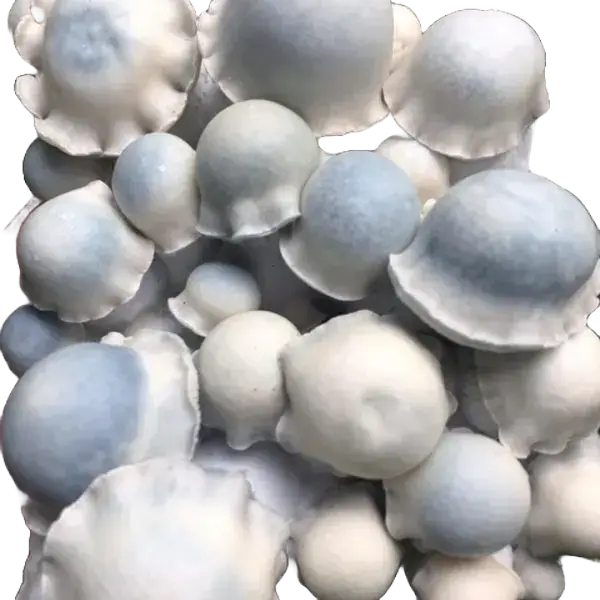
Ready to work with one of mycology’s most fascinating mutations? Enigma represents the cutting edge of cubensis genetics.
Explore Enigma Liquid CultureHow to Choose the Right Cubensis Strain for Your Research
Choosing your first strain—or adding a new variety to your collection—shouldn’t feel like throwing darts at a board. The key is matching strain characteristics to your specific situation, experience level, and research goals. Let me walk you through the decision-making process I use when recommending strains to fellow mycology enthusiasts.
Consider Your Experience Level
If you’re just getting started with microscopy and cultivation research, resist the temptation to jump straight into exotic varieties. Beginner-friendly strains like Golden Teacher, DCM-95, or Albino Bluey Vuitton are forgiving when you make mistakes (and you will make mistakes—we all do). These strains colonize reliably, tolerate minor temperature fluctuations, and fruit predictably, giving you the confidence boost you need to develop your technique.
Once you’ve successfully worked with a few beginner strains and understand the fundamentals of sterile technique, colonization monitoring, and fruiting conditions, you’re ready to tackle intermediate varieties. Strains like Jack Frost, Blue Meanie, or Leucistic Golden Teacher reward proper technique with stunning results but are less forgiving of contamination or environmental inconsistencies.
Advanced strains demand precision and experience. Ingeli, for instance, requires specific humidity and temperature parameters that beginners often struggle to maintain. Enigma doesn’t produce spores at all, requiring liquid culture or agar work that presumes you’re comfortable with advanced techniques. Don’t let ego push you toward advanced strains before you’re ready—there’s no shame in mastering the fundamentals first.
Define Your Research Goals
Are you primarily interested in microscopy work, examining spore morphology and characteristics? Then you’ll want strains that produce abundant, high-quality spore prints. Golden Teacher, Hillbilly, and Leucistic Golden Teacher excel in this department, dropping dense purple-black prints perfect for slide preparation and long-term storage.
If you’re more focused on studying growth patterns, fruiting behaviors, or isolation techniques, consider strains with interesting morphological features. Squat Mac produces uniquely compact fruits perfect for observing cluster development. Gandalf offers distinctive tall, slender fruits that demonstrate fascinating stem elongation patterns.
For researchers interested in genetic diversity and comparison studies, building a collection that spans the phenotypic spectrum makes sense. Start with a standard strain like Golden Teacher as your baseline, then add albino varieties (APE, Jack Frost, Yeti 168), leucistic variants (Leucistic Golden Teacher), and unusual mutations (Enigma) to understand the full range of genetic expression possible within the species.
Evaluate Your Growing Environment
Your physical setup matters more than you might think. Do you live in a hot climate without air conditioning? Heat-tolerant strains like Minami Okinawa (originally from subtropical Japan) or Hillbilly (from the warm Arkansas climate) handle temperature fluctuations better than more temperature-sensitive varieties.
Working with limited space or a smaller fruiting chamber? Compact strains like Squat Mac or dense fruiters like Azul APE maximize yields in confined spaces. Conversely, if you have a large Martha tent or greenhouse setup, you can accommodate taller varieties like Gandalf or sprawling fruiters like Cosmic Ghost Rider.
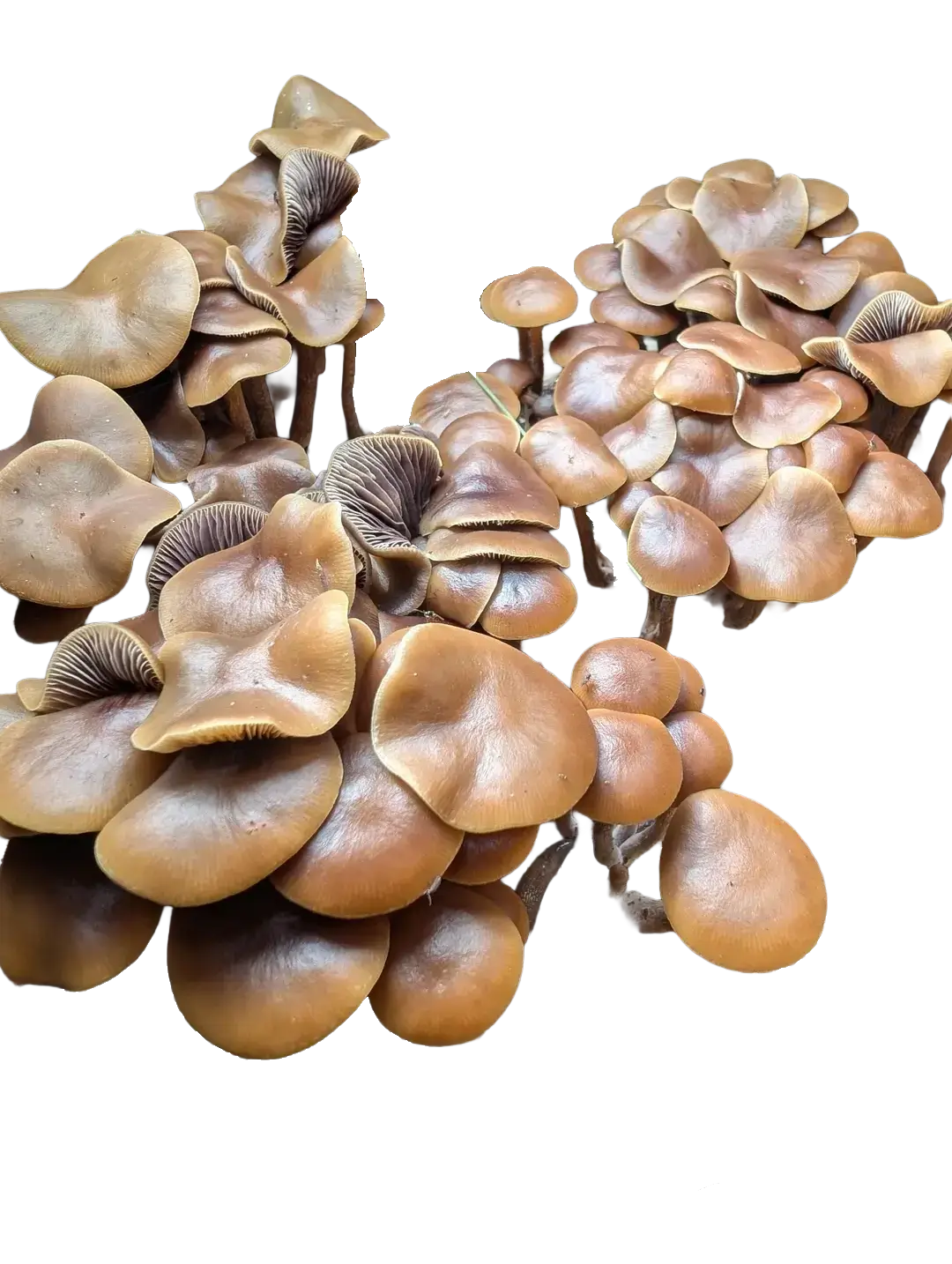
Consider Aesthetic Preferences
Let’s be honest—part of the appeal of working with different cubensis strains is simply how beautiful they are. There’s genuine satisfaction in witnessing a flush of ghostly-white Yeti 168 emerge from substrate, or watching the distinctive blue hues develop on Albino Bluey Vuitton caps.
If visual appeal drives your collection-building, prioritize strains with distinctive characteristics. Albino varieties (APE, Jack Frost, Avery Albino, Cosmic Ghost Rider) create stunning contrast against typical substrate. Leucistic strains offer ethereal pale coloration. And mutations like Enigma produce forms unlike anything else in the mushroom kingdom—truly one-of-a-kind morphology that never fails to impress.
Factor in Availability and Genetics
Some strains are more readily available than others, and there’s usually a good reason for that. Widely available strains like Golden Teacher, B+, or Cambodian have proven themselves reliable across thousands of grows and countless environmental conditions. They’re the workhorses of mycology research for good reason.
Rarer strains or newer isolations might be harder to source, but they often represent the cutting edge of genetic selection. Ingeli, only recently identified as a distinct species, offers researchers a chance to work with genetics that have barely been studied in cultivation. Yeti 168 represents years of careful isolation work to stabilize the True Albino Teacher phenotype.
When choosing between similar strains, consider documented genetics and lineage. A strain with clear provenance and multiple generations of selection work typically performs more predictably than mystery genetics or unverified isolations.
Psilocybe Cubensis Growing Fundamentals
While each strain has its peculiarities (covered in depth in the individual cultivation guides), all P. cubensis varieties share fundamental requirements that form the foundation of successful mycology work. Master these basics, and you’ll be able to adapt to almost any strain’s specific needs.
Temperature Requirements
P. cubensis is remarkably temperature-tolerant compared to other psilocybin species, but optimal performance occurs within specific ranges. During colonization, maintain temperatures between 75-81°F (24-27°C). Most strains colonize fastest at the upper end of this range, though some heat-sensitive varieties prefer the lower end. Once you initiate fruiting conditions, slightly cooler temperatures of 70-76°F (21-24°C) encourage proper primordia formation and fruit development.
Temperature stability matters more than hitting exact numbers. Wild fluctuations stress mycelium and create opportunities for contamination. If you can’t maintain perfect temperatures, err on the cooler side—cubensis tolerates temperatures down to 65°F (18°C) reasonably well, just with slower growth. Sustained temperatures above 85°F (29°C) risk contamination and can kill mycelium.
Humidity and Fresh Air Exchange
During colonization, substrate needs minimal fresh air exchange but high relative humidity—around 90-95%. This prevents substrate from drying out while allowing mycelium to spread efficiently. Once you introduce fruiting conditions, you’re balancing two competing needs: maintaining 90-95% humidity for proper fruit development while providing frequent fresh air exchange to prevent carbon dioxide buildup.
This is where many beginners struggle. Too much FAE dries out substrate and aborts pins. Insufficient FAE produces long, fuzzy stems as fruits stretch toward oxygen. The sweet spot varies by strain—dense fruiters like APE tolerate slightly less FAE, while vigorous varieties like Blue Meanie demand generous air exchange. Your individual cultivation guides provide strain-specific FAE recommendations.
Light Requirements
Contrary to popular belief, P. cubensis doesn’t need intense light for fruiting. Mycelium uses light primarily as a directional cue, telling it which way is “up” for fruit body formation. Ambient room light or 12 hours of indirect artificial light daily is sufficient for all cubensis strains. Some growers prefer 6500K LED bulbs that mimic natural daylight spectrum, but this is aesthetic preference rather than necessity.
What matters more than intensity is consistency. Maintain a regular light schedule—12 hours on, 12 hours off works perfectly—so mycelium can establish circadian rhythms. Irregular lighting confuses the organism and can delay or reduce fruiting.
Substrate Selection
P. cubensis is famously adaptable regarding substrate choice, colonizing everything from simple brown rice flour cakes to complex hardwood-supplemented blends. For beginners, I recommend starting with a basic coco coir and vermiculite mix at field capacity—this provides adequate nutrition, retains moisture well, and resists contamination better than heavily supplemented substrates.
As you gain experience, you can experiment with substrate additions that boost yields: gypsum for texture and pH buffering, spent coffee grounds for extra nitrogen, worm castings for trace minerals, or small amounts of grain spawn for additional nutrition. Each strain responds slightly differently to substrate composition—aggressive colonizers like DCM-95 handle supplementation well, while slower strains might struggle with the increased contamination risk that comes with nutrient-rich substrates.
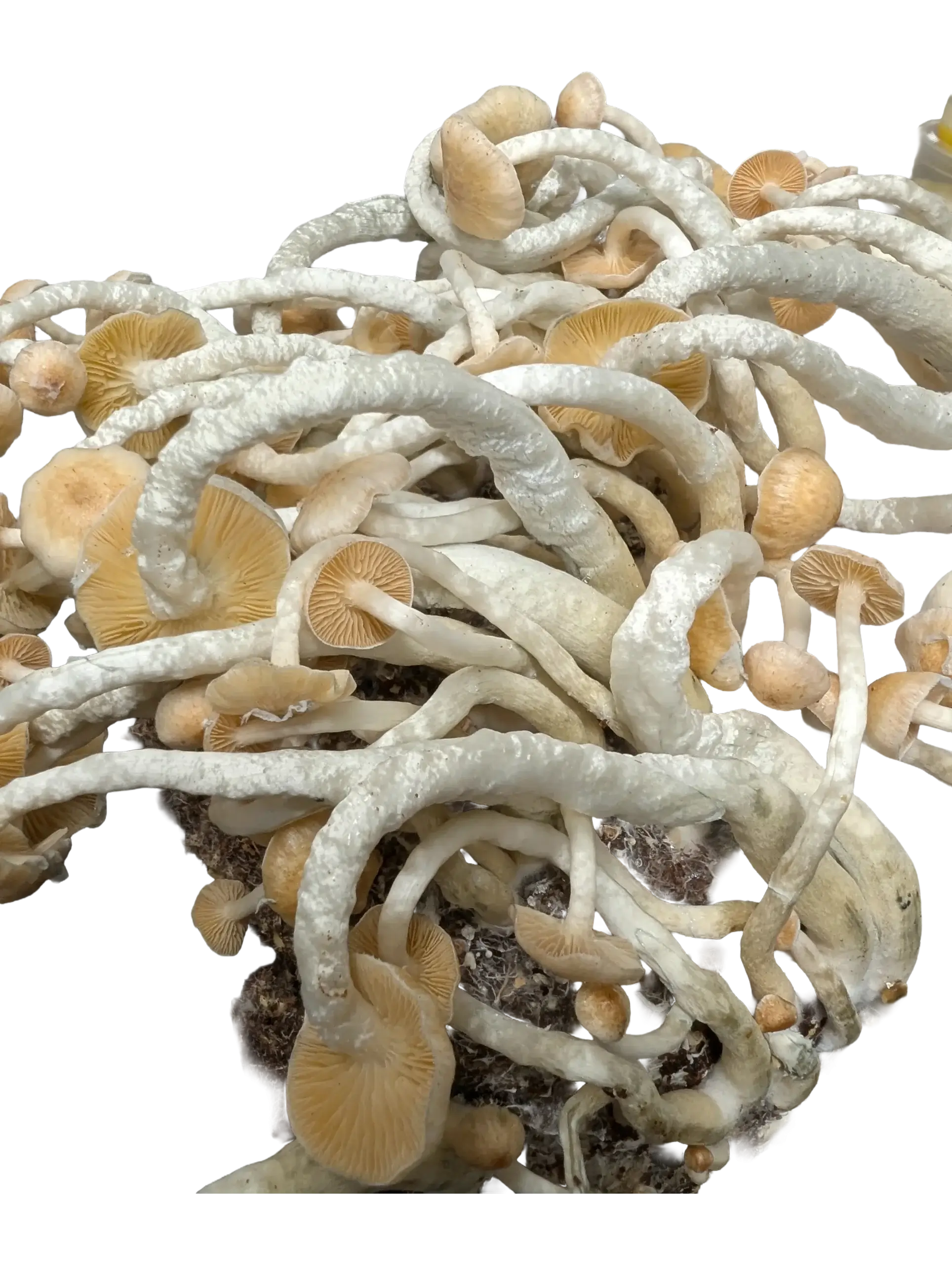
Colonization Timeline and Monitoring
Colonization speed varies significantly by strain. Fast colonizers like Blue Meanie or DCM-95 can fully colonize substrate in 10-14 days under optimal conditions. Slower strains like Enigma (when working from liquid culture) might take 21-28 days or longer. Penis Envy genetics (APE, Azul APE) typically fall somewhere in the middle at 14-21 days.
During colonization, monitor for signs of healthy mycelial growth: white, rope-like rhizomorphic growth spreading from inoculation points, sweet or mushroomy aroma (not sour or fermenting), and even colonization progression across the substrate surface. Contamination appears as green, black, pink, or yellow patches, often accompanied by off odors. Catch contamination early, remove affected containers immediately, and review your sterile technique.
Fruiting Conditions and Pinning
Once substrate is fully colonized, you initiate fruiting by introducing the environmental trigger—increased fresh air exchange, slightly lower temperatures, and maintained high humidity. Within 5-10 days, you should see primordia (tiny mushroom pins) forming, usually in clusters where conditions are most favorable.
This is the most exciting phase, watching your research subjects develop from microscopic pins into full fruits. Different strains show distinctive pinning patterns. Some fruit in dense clusters (Squat Mac, Hillbilly), others produce scattered individuals (Gandalf, Cosmic Ghost Rider). Albino varieties often pin more slowly than pigmented strains but compensate with impressive final size.
Harvesting and Spore Collection
Harvest timing depends on your goals. For optimal tissue samples, harvest just before or as veils break—this is when fruits contain peak active compound concentrations. For spore collection, allow several fruits to fully mature until caps flatten and begin dropping spores, then take prints from the most representative specimens.
After harvesting your first flush, the substrate typically produces 2-4 additional flushes with diminishing yields. Between flushes, rehydrate substrate by soaking or heavy misting, then return to fruiting conditions. Each flush provides opportunities to observe strain behavior, collect spores, and document morphological variations.
Legal Considerations for Psilocybe Cubensis Research
Before diving into P. cubensis research, understanding the legal landscape is essential. This gets confusing quickly because laws vary dramatically by jurisdiction and often contain important nuances that casual observers miss.
In most of the United States, psilocybin and psilocin—the active compounds found in mature mushrooms—are Schedule I controlled substances. Possession, cultivation, or distribution of mature fruiting bodies is federally illegal. However, and this is the critical distinction, spores themselves contain no psilocybin or psilocin. They’re simply the reproductive cells of the organism, analogous to seeds.
Because spores don’t contain controlled substances, they’re legal to possess and study for microscopy, taxonomy, and mycology research purposes in most states. The major exceptions are California, Georgia, and Idaho, where even spore possession is explicitly illegal. If you’re in one of these states, you cannot legally acquire P. cubensis spores under current law.
Important Legal Distinctions
Spore syringes and prints sold for microscopy research are legal in 47 states. Once germinated, mycelium technically contains trace amounts of psilocybin, creating a legal gray area. Mature fruiting bodies are federally illegal everywhere in the US, regardless of intended use. Atlas Spores sells spores exclusively for microscopy, taxonomy, and educational research—never for cultivation of controlled substances. We ship only to jurisdictions where spore possession is legal.
Several cities and states have recently decriminalized or legalized psilocybin in various forms. Oregon pioneered legal psilocybin therapy through Measure 109. Colorado followed with similar legislation. Cities including Denver, Oakland, Santa Cruz, Ann Arbor, Seattle, and Washington DC have decriminalized possession. These changes don’t affect spore legality (which was already legal) but reflect evolving attitudes toward psilocybin research and therapeutic use.
For researchers outside the United States, laws vary even more widely. Canada treats psilocybin spores similarly to the US—legal for microscopy, illegal once cultivated. The UK and most of Europe prohibit cultivation but have varying approaches to spore possession. Australia recently rescheduled psilocybin for medical use under specific circumstances. Always verify current laws in your specific jurisdiction before acquiring any mycological research materials.
The key takeaway: if you’re engaging in legitimate microscopy research, maintaining proper documentation, and staying within legal boundaries, P. cubensis spore research is accessible to most enthusiasts. Our comprehensive legal guide provides more detailed jurisdiction-specific information and updates as laws continue evolving.
Frequently Asked Questions About Psilocybe Cubensis Strains
What’s the best Psilocybe cubensis strain for beginners?
Golden Teacher consistently ranks as the top beginner strain due to its reliable genetics, forgiving nature, and excellent spore production. It tolerates minor temperature fluctuations, colonizes predictably, and fruits abundantly even when conditions aren’t perfect. DCM-95 and Albino Bluey Vuitton are also excellent beginner choices, offering similar reliability with slightly different characteristics. Start with one of these three, master the fundamentals, then expand to more challenging varieties.
Are albino cubensis strains harder to grow than regular strains?
Not necessarily. While some albino genetics (like original Penis Envy) can be temperamental, many modern albino isolations like APE, Jack Frost, or Albino Bluey Vuitton are actually quite beginner-friendly. Albinism is simply a pigmentation mutation and doesn’t inherently affect cultivation difficulty. That said, albino strains sometimes colonize slightly slower and produce fewer spores, but these are minor considerations rather than significant challenges.
Do different cubensis strains require different growing conditions?
All P. cubensis strains share the same fundamental requirements—similar temperature ranges, humidity levels, and substrate preferences. However, individual strains have preferences within those ranges. For example, Minami Okinawa tolerates higher temperatures than average, Enigma needs slightly longer colonization periods, and dense fruiters like APE benefit from increased FAE during pinning. These nuances are covered in each strain’s specific cultivation guide, but beginners can successfully grow any cubensis strain using standard parameters.
Why doesn’t Enigma produce spores?
Enigma is a blob mutation that produces thick, brain-like masses instead of traditional mushroom structures with gills and spore-producing surfaces. Without gills, there’s no mechanism for spore production. This means Enigma can only be propagated through tissue culture or liquid culture—you can’t take spore prints. This makes it more challenging to work with but also creates a unique research opportunity to study a dramatic morphological mutation within the cubensis species.
What’s the difference between Penis Envy, Albino Penis Envy, and Azul APE?
These are all genetic relatives within the Penis Envy lineage. Original Penis Envy features extremely thick stems, small caps, and dense fruits with rich brown coloration. Albino Penis Envy (APE) carries the same thick, dense genetics but with true albinism—completely white fruits. Azul APE is a further isolation of APE that exhibits enhanced blue coloration when bruised. All three share the characteristic PE morphology but differ in pigmentation and specific growth characteristics.
Can I grow multiple cubensis strains in the same fruiting chamber?
Yes, absolutely. Since all cubensis strains have similar environmental requirements, you can fruit multiple varieties simultaneously in the same chamber. This is actually a great way to directly compare strain characteristics under identical conditions. Just maintain proper labeling to avoid confusion, and be aware that some strains might fruit at slightly different rates. Fast fruiters might produce several flushes while slower strains are still on their first.
How long do Psilocybe cubensis spore syringes remain viable?
When properly stored in a refrigerator at 36-46°F (2-8°C), P. cubensis spore syringes remain viable for 6-12 months, sometimes longer. The key is keeping them cool, dark, and sealed. Never freeze spore syringes—ice crystals damage spore walls. For long-term storage beyond a year, spore prints are superior, remaining viable for several years when properly dried and stored in cool, dark conditions. Check out our comprehensive storage guide for detailed preservation techniques.
What does “isolation” mean when referring to cubensis strains?
Isolation refers to the process of selecting and propagating specific genetic traits through deliberate breeding. When a cultivator notices a mushroom with desirable characteristics—unusual coloration, impressive size, unique morphology—they can isolate that genetics by cloning tissue samples or working with monokaryotic cultures. Through successive generations of selection, these traits become stabilized, eventually creating a distinct “strain.” Many modern cubensis varieties like Yeti 168, DCM-95, and Cosmic Ghost Rider are sophisticated isolations representing years of selection work.
Are Psilocybe natalensis and Psilocybe ingeli the same as cubensis?
No, these are distinct species, though closely related. P. natalensis and P. ingeli are both native to South Africa and were only recently identified as separate species from cubensis. They share similar active compounds but have different morphological characteristics, spore sizes, and cultivation requirements. Natalensis typically fruits more prolifically than cubensis but prefers slightly different temperature ranges. Ingeli is the most recently described species (2024) and requires more advanced cultivation techniques. We include them in our catalog because they appeal to researchers interested in species diversity beyond standard cubensis genetics.
Should I start with spore syringes or liquid culture for my first grow?
For beginners, spore syringes are the better choice. They’re more forgiving, easier to work with, require less specialized technique, and allow you to observe the complete organism life cycle from spore germination through fruiting. Liquid culture colonizes faster and more reliably, but it requires more advanced sterile technique and you miss the educational experience of watching spores germinate. Once you’ve successfully completed a few grows with spore syringes and feel confident in your contamination prevention skills, then explore liquid culture for improved efficiency. Our detailed comparison guide breaks down the pros and cons of each approach.
Your Psilocybe Cubensis Journey Starts Here
We’ve covered a lot of ground—from the taxonomy and biology of P. cubensis to the specific characteristics that make each strain unique, from fundamental growing principles to legal considerations that keep your research above board. If you’re feeling a bit overwhelmed, that’s completely normal. Mycology is a deep field with endless rabbit holes to explore.
Here’s what I want you to remember: every expert mycologist started exactly where you are now, staring at a comparison table and wondering which strain to choose first. The beauty of working with cubensis is that there’s no single “right” answer. Golden Teacher makes a phenomenal first strain, but so does DCM-95, or Hillbilly, or Albino Bluey Vuitton. What matters most isn’t choosing the “perfect” strain—it’s starting the journey, learning from inevitable mistakes, and building your skills methodically.
Start with a beginner-friendly variety, work through a complete life cycle from spore to print, document your process, and learn from each grow. Once you’ve got a few successful grows under your belt, branch out. Try an albino variety to see how pigmentation affects growth patterns. Experiment with a mutation like Enigma to understand how dramatically genetics can vary. Build a collection that showcases the incredible diversity possible within a single species.
The individual strain guides linked throughout this article provide the detailed roadmaps you need for each variety. They cover strain-specific quirks, optimal parameters, common challenges, and advanced techniques that maximize your success. Think of this pillar guide as your 30,000-foot overview of the cubensis landscape, while the individual guides are your turn-by-turn navigation for specific journeys.
Remember that mycology is as much art as science. Two people can follow identical protocols and get different results based on countless environmental variables. That’s not frustrating—it’s fascinating. Each grow teaches you something new about how these organisms respond to conditions, how genetics express themselves, and how small adjustments create big impacts. Embrace the learning process, celebrate the successes, learn from the failures, and most importantly, document everything. Your future self will thank you when you’re trying to replicate exceptional results or troubleshoot unexpected issues.
Ready to Build Your Mycology Collection?
Our Humble Bundle gives you access to multiple premium cubensis strains at an unbeatable value, perfect for researchers who want to explore genetic diversity without breaking the bank. Compare different varieties side-by-side, build your spore library, and discover which strains resonate with your research style—all while getting exceptional value on genetics that represent years of careful selection and isolation work.
Get the Humble Bundle Now
